

Lit Hub's Most Anticipated Books of 2020. Considering the fact that it was the end of the decade, and that we’re all trying to distract ourselves from the encroaching heat death of the planet, it’s not surprising that the 2019/2020 list season on the literary internet has been particularly robust—and much too long.
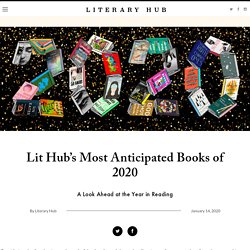
That said, we couldn’t help but end it with a bang. For our very last list (of this kind anyway) of the season, we hereby present the 281 (sorry, we couldn’t help it, all other lists must die by our hand) 2020 books most eagerly anticipated by the Literary Hub staff. Graphic Novels, Comics & Manga. 3 On A YA Theme: Characters With Disabilities. Protecting Students Against the Effects of Poverty: Libraries. Free Voluntary reading: New Research, Applications, and Controversies.
Scholastic Professional: Professional Growth books. School Librarian's Role in Reading Toolkit. Wide Open Spaces: Learning from "Not-Just-Right" Books. Every mother can relate to this maternal wisdom: The car is a perfect place for insightful conversations with your child. When my seven year old waits to share exciting news, secret concerns, or silly stories from the back seat, I am pleased but at the same time I wonder if she has figured out that drive time is a safe time to share her thoughts; has she decided and discovered that her A-type, energized teacher-mom cannot over-react, over-analyze, or over-talk while driving?
I always try and take the time to journal about the car lessons my child shares as I wrestle with the universal parenting/teaching dilemma: when do you need to be the involved expert and when do you need to be a quiet listener? The Big Fresh October 3, 2015 The Tyranny of Levels. Education has produced a vast population able to read, but unable to distinguish what is worth reading.
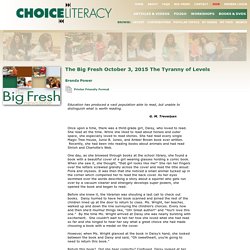
G. M. Trevelyan Once upon a time, there was a third-grade girl, Daisy, who loved to read. What I am thinking about – Part 1 – Leveling the Library. Using Images as Scaffolds for Reading Complex Text – School Library Connection Blog. April at School Library Connection has been all about inquiry—but we’ve got inquiry on the brain all year long!
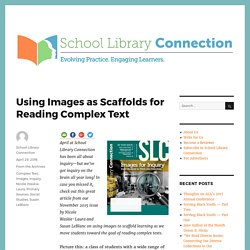
In case you missed it, check out this great article from our November 2015 issue by Nicole Waskie-Laura and Susan LeBlanc on using images to scaffold learning as we move students toward the goal of reading complex texts. Picture this: a class of students with a wide range of reading levels and abilities engaging deeply with the same introductory text. The topic and text are unfamiliar, yet the students that typically struggle to read are leading the text-based conversations. As the lesson progresses, the room buzzes with conversation as students grapple with the information in the text, ask inquisitive questions of their peers, and provide evidence-based answers. Top 10 ways to use technology to promote reading. I only steal from the best.
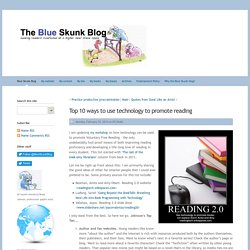
So here we go. Johnson's Top Ten... Author and fan websites. Young readers like know more “about the author” and the Internet is rich with resources produced both by the authors themselves, their publishers, and their fans. Teaching Students How to Set a Purpose for Reading. Stamina Bubbles. 25 Reading Strategies That Work In Every Content Area. 25 Reading Strategies That Work In Every Content Area.
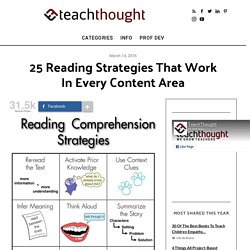
Questioning That Deepens Comprehension. Editor's note: This post is co-authored by Nancy Frey, a Professor of Literacy in Educational Leadership at San Diego State University and a credentialed special educator, reading specialist, and administrator.
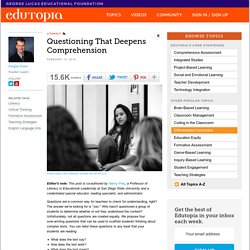
Questions are a common way for teachers to check for understanding, right? The answer we’re looking for is "yes. " Who hasn't questioned a group of students to determine whether or not they understood the content? Unfortunately, not all questions are created equally. We propose four over-arching questions that can be used to scaffold students' thinking about complex texts. What does the text say? What does the text say? The questions in this category require students to think literally about the text. The amount of time that teachers spend at the literal level will vary based on student responses. Questions at this level could include: One Book, One School: Building Community with Shared Text. Some time ago I had the opportunity to read an early copy of R.J.
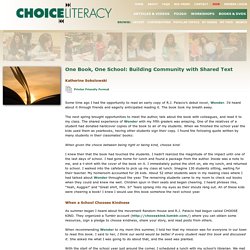
A readers manifesto – cartoon. For the Children's Publishing Industry. Charlotte Mecklenburg Library. Book Lists. Best Books for Young Adults. *YALSA has launched the new Teen Book Finder Database, which is a one-stop shop for finding selected lists and award winners. Users can search this free resource by award, list name, year, author, genre and more, as well as print customizable lists. This new resource will replace the individual award and list web pages currently on YALSA’s site that are not searchable and that are organized only by year.
Policies and Procedures | Previous Lists | Previous Top 10 Lists | BBYA Publications Through 2010, The Best Books for Young Adults committee each year selected and annotated a list of significant adult and young adult books, as well as chooses a list of top ten titles from the full list. It is a general list of fiction and nonfiction titles selected for their proven or potential appeal to the personal reading tastes of the young adult. Best Books for Young Adults evolved into Best Fiction for Young Adults after the 2010 BBYA list was published. Current List 2010 Best Books for Young Adults. Association for Library Service to Children (ALSC) 2018 ALSC Book & Media Award winners 2018 Award Acceptance Speeches 2017 Book and Media Awards 2017 Award Acceptance Speeches Watch the 2017 Newbery-Caldecott-Wilder Banquet View Reaction Videos from the 2017 Youth Media Award Winners 2016 Book and Media Awards 2016 Award Acceptance Speeches.
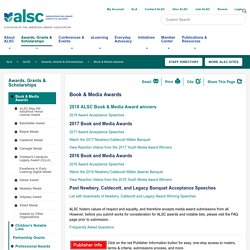
Picture Books or Beginning Readers? A few weeks ago, Kim and Lily were snuggled in a beanbag chair with their heads together. They were trying to decipher some troublesome words in a book. “Sat? Seat?” Tried Kim. 29 best images about Mentor Texts for Nonfiction Text Structures on Pinterest. Make love of reading the first objective. The myths we allow ourselves to believe about reading will continue to shape the reading lives of those we teach.
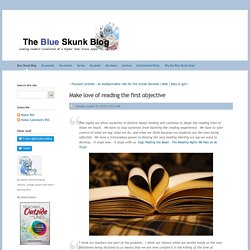
Learning To Read Alone Is Not Enough. Your Students Need A Reading Champion. I don't know about you, but...

Scholastic Releases New National Research on Children’s Reading (Kids & Family Reading Report, 6th Ed.) Kids and Family Reading Report. How Can School and Classroom Libraries Support Struggling Readers? In her article Room for Beliefs, Debbie Miller says, "Step outside your classroom door and look back in, as if for the first time. Trelease Brochures on Reading. Heart of the School. Share17 Have a look at some of these reports, all of which stress the importance of reading for pleasure and educational achievement. Book Talks by Katherine Sokolowski. I recently gave my students an end of the quarter survey to see how they felt the year was going. In looking at survey after survey, my seventh graders repeatedly listed our daily book talks as one of their favorite parts of our class. They had positive things to say about finding other kids in class who liked the same books they did, discovering new books to add to their to read list, and the community feel of all of us gathering in the front of the room to begin our day.
Speed Dating Books. School Librarian's Role in Reading Toolkit. 12 Ways to Nurture a Love of Reading. As a classroom teacher, nurturing a love of reading in my students was almost an obsession. This continued when I had a child. 10 Tips to Create Great Readers.